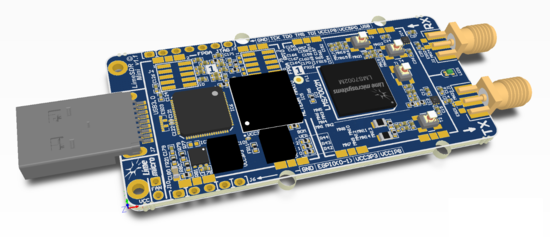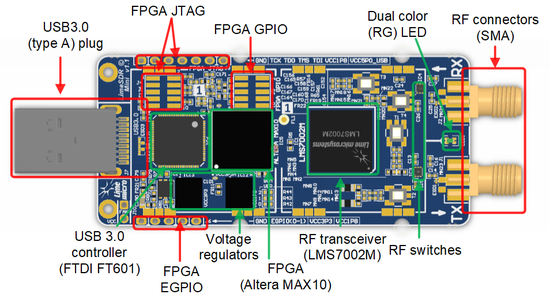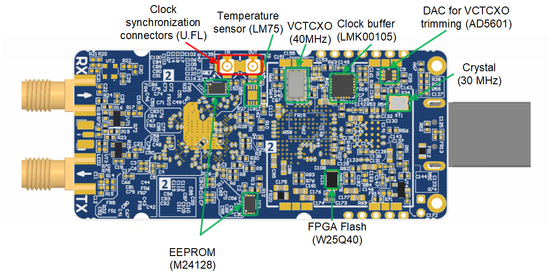LimeSDR-Mini v1.1 hardware description: Difference between revisions
Jump to navigation
Jump to search
(Created page with "TBD") |
No edit summary |
||
| Line 1: | Line 1: | ||
== LimeSDR-Mini Board Key Features == | |||
The LimeSDR-Mini is low-cost software defined radio board. LimeSDR-Mini development board provides a hardware platform for developing and prototyping high-performance and logic-intensive digital and RF designs using Intel’s MAX 10 FPGA and Lime Microsystems transceiver. | |||
[[File:LimeSDR-Mini_v1.1.png|center|550px|LimeSDR-Mini v1.1 ]] | |||
LimeSDR-Mini board features: | |||
* '''USB 3.0 controller: FTDI FT601''' | |||
* '''FPGA: Intel MAX 10 (10M16SAU169C8G 169-UBGA)''' | |||
** 169-pin FBGA package | |||
** 16 K LE | |||
** 549 Kb M9K Memory | |||
** 2368 Kb User Flash Memory | |||
** 1x fractional phase locked loops (PLLs) | |||
** 45x 18x18-bit multipliers | |||
** 130x general purpose input/output (GPIO) | |||
** Single supply | |||
** Flash feature | |||
** FPGA configuration via JTAG | |||
* '''RF transceiver: Lime Microsystems LMS7002M''' | |||
* '''EEPROM Memory: 2x 128Kb EEPROMs for LMS MCU firmware and FPGA data''' | |||
* '''FLASH Memory: 4Mb Flash memory for FPGA data''' | |||
* '''Temperature sensor (unpopulated)''' | |||
* '''General user inputs/outputs:''' | |||
** 1x Dual colour (RG) LED | |||
** 8x + 2x FPGA GPIO pinheader (3.3V) | |||
* '''Connections:''' | |||
** USB3.0 (type A) plug | |||
** Coaxial RF (SMA female) connectors | |||
** FPGA GPIO headers (unpopulated) | |||
** FPGA JTAG connector (unpopulated) | |||
** FAN (5V or 3.3V) connector | |||
* '''Clock system:''' | |||
** 40.00MHz onboard VCTCXO | |||
** Possibility to trim VCTCXO by onboard DAC | |||
** Reference clock input and output connectors (U.FL) | |||
* '''Board size: 69mm x 31.4mm''' | |||
For more information on the following topics, refer to the respective documents: | |||
* '''FTDI FT601 USB 3.0 to FIFO Bridge datasheet [link]''' | |||
* '''MAX 10 FPGA device family, refer to MAX 10 Device Handbook [link] ''' | |||
* '''LMS7002M transceiver resources [link]''' | |||
== Board Overview == | |||
This section contains component location description on the board. LimeSDR-Mini board picture with highlighted connectors and main components is presented in Figure 2 and Figure 3. | |||
[[File:LimeSDR-Mini_v1.1_top_componens.png|center|550px|LimeSDR-Mini v1.1 board top connectors and main components ]] | |||
[[File:LimeSDR-Mini_v1.1_bot_componens.png|center|550px|Figure 3 LimeSDR-Mini v1.1 board bottom connectors and main componentsc ]] | |||
Board components description listed in the Table 1 and Table 2. | |||
{| class="wikitable" | |||
|+ Table 1. Board components | |||
! colspan="3"|Featured Devices | |||
|- | |||
! Board reference !! Type !! Description | |||
|- | |||
| IC1 || FPRF || Field programmable RF transceiver, LMS7002M | |||
|- | |||
| IC5 || FPGA || Intel MAX 10 (10M16SAU169C8G 169-UBGA) | |||
|- | |||
| IC6 || USB 3.0 microcontroller || Intel MAX 10 (10M16SAU169C8G 169-UBGA) | |||
|- | |||
! colspan="3"|Miscellaneous devices onboard | |||
|- | |||
| IC9 || IC || Quad SPDT switch, TS3A5018PW | |||
|- | |||
| IC6 || IC || Temperature sensor, LM75 | |||
|- | |||
| IC19 || IC || SPI to I²C bridge, SC18IS602BIPW (not mounted) | |||
|- | |||
| IC17 || IC || I²C port expander with 4 push-pull outputs and 4 inputs, MAX7322ATE+ | |||
|- | |||
! colspan="3"|Configuration, Status and Setup Components | |||
|- | |||
| IC9 || IC || Quad SPDT switch, TS3A5018PW | |||
|- | |||
| R51, R52, R53, R54, R56, R57, R59, R60 || 0 Ohm resistor || FPGA (IC31) MSEL[3:0]. Default mode: Active Serial Standard configuration | |||
|- | |||
| R115, R116, R117 || 10 kOhm resistor || USB3.0 microcontroller (IC13) boot configuration (PMODE0[2:0]) resistors. Default mode: SPI boot, On Failure - USB Boot | |||
|- | |||
| R125, R127, R128 || 10 kOhm resistor || USB3.0 microcontroller (IC13) crystal/clock frequency selection (FSLC[2:0]) resistors. Default mode: 19.2MHz crystal | |||
|- | |||
| J16 || JTAG chain pin header || USB3.0 (IC6) microcontroller’s debugging pin header, 0.05” pitch | |||
|- | |||
| J17, R122 || Pin header || USB3.0 microcontroller boot source (Flash memory or USB), 0.05” pitch jumper or 0402 0R resistor. In normal operation jumper or resistor must be placed. | |||
|- | |||
| SW1 || Push-button || USB3.0 microcontroller reset button | |||
|- | |||
| J11 || JTAG chain pin header || FPGA programming pin header for Altera USB-Blaster download cable, 0.05” pitch | |||
|- | |||
| LEDS1 || Red-green status LEDs || User defined FPGA indication LED1 (near board edge if SMD; on the bottom if through-hole), User defined FPGA indication LED2 (farther board edge if SMD; on the top if through-hole) | |||
|- | |||
| LEDS2 || Red-green status LEDs || FX3 (USB) status indication LED (near board edge if SMD; on the bottom if through-hole), board power indication LED (farther board edge if SMD; on the top if through-hole) | |||
|- | |||
! colspan="3"|General User Input/Output | |||
|- | |||
| J12 || Pin header || 8 FPGA GPIOs, 0.05” pitch | |||
|- | |||
| J13, J14 || Pin header || 3.3V fan connection pin headers, 0.1” and 0.05” pitch respectively | |||
|} | |||
Revision as of 06:29, 20 February 2018
LimeSDR-Mini Board Key Features
The LimeSDR-Mini is low-cost software defined radio board. LimeSDR-Mini development board provides a hardware platform for developing and prototyping high-performance and logic-intensive digital and RF designs using Intel’s MAX 10 FPGA and Lime Microsystems transceiver.

LimeSDR-Mini board features:
- USB 3.0 controller: FTDI FT601
- FPGA: Intel MAX 10 (10M16SAU169C8G 169-UBGA)
- 169-pin FBGA package
- 16 K LE
- 549 Kb M9K Memory
- 2368 Kb User Flash Memory
- 1x fractional phase locked loops (PLLs)
- 45x 18x18-bit multipliers
- 130x general purpose input/output (GPIO)
- Single supply
- Flash feature
- FPGA configuration via JTAG
- RF transceiver: Lime Microsystems LMS7002M
- EEPROM Memory: 2x 128Kb EEPROMs for LMS MCU firmware and FPGA data
- FLASH Memory: 4Mb Flash memory for FPGA data
- Temperature sensor (unpopulated)
- General user inputs/outputs:
- 1x Dual colour (RG) LED
- 8x + 2x FPGA GPIO pinheader (3.3V)
- Connections:
- USB3.0 (type A) plug
- Coaxial RF (SMA female) connectors
- FPGA GPIO headers (unpopulated)
- FPGA JTAG connector (unpopulated)
- FAN (5V or 3.3V) connector
- Clock system:
- 40.00MHz onboard VCTCXO
- Possibility to trim VCTCXO by onboard DAC
- Reference clock input and output connectors (U.FL)
- Board size: 69mm x 31.4mm
For more information on the following topics, refer to the respective documents:
- FTDI FT601 USB 3.0 to FIFO Bridge datasheet [link]
- MAX 10 FPGA device family, refer to MAX 10 Device Handbook [link]
- LMS7002M transceiver resources [link]
Board Overview
This section contains component location description on the board. LimeSDR-Mini board picture with highlighted connectors and main components is presented in Figure 2 and Figure 3.


Board components description listed in the Table 1 and Table 2.
| Featured Devices | ||
|---|---|---|
| Board reference | Type | Description |
| IC1 | FPRF | Field programmable RF transceiver, LMS7002M |
| IC5 | FPGA | Intel MAX 10 (10M16SAU169C8G 169-UBGA) |
| IC6 | USB 3.0 microcontroller | Intel MAX 10 (10M16SAU169C8G 169-UBGA) |
| Miscellaneous devices onboard | ||
| IC9 | IC | Quad SPDT switch, TS3A5018PW |
| IC6 | IC | Temperature sensor, LM75 |
| IC19 | IC | SPI to I²C bridge, SC18IS602BIPW (not mounted) |
| IC17 | IC | I²C port expander with 4 push-pull outputs and 4 inputs, MAX7322ATE+ |
| Configuration, Status and Setup Components | ||
| IC9 | IC | Quad SPDT switch, TS3A5018PW |
| R51, R52, R53, R54, R56, R57, R59, R60 | 0 Ohm resistor | FPGA (IC31) MSEL[3:0]. Default mode: Active Serial Standard configuration |
| R115, R116, R117 | 10 kOhm resistor | USB3.0 microcontroller (IC13) boot configuration (PMODE0[2:0]) resistors. Default mode: SPI boot, On Failure - USB Boot |
| R125, R127, R128 | 10 kOhm resistor | USB3.0 microcontroller (IC13) crystal/clock frequency selection (FSLC[2:0]) resistors. Default mode: 19.2MHz crystal |
| J16 | JTAG chain pin header | USB3.0 (IC6) microcontroller’s debugging pin header, 0.05” pitch |
| J17, R122 | Pin header | USB3.0 microcontroller boot source (Flash memory or USB), 0.05” pitch jumper or 0402 0R resistor. In normal operation jumper or resistor must be placed. |
| SW1 | Push-button | USB3.0 microcontroller reset button |
| J11 | JTAG chain pin header | FPGA programming pin header for Altera USB-Blaster download cable, 0.05” pitch |
| LEDS1 | Red-green status LEDs | User defined FPGA indication LED1 (near board edge if SMD; on the bottom if through-hole), User defined FPGA indication LED2 (farther board edge if SMD; on the top if through-hole) |
| LEDS2 | Red-green status LEDs | FX3 (USB) status indication LED (near board edge if SMD; on the bottom if through-hole), board power indication LED (farther board edge if SMD; on the top if through-hole) |
| General User Input/Output | ||
| J12 | Pin header | 8 FPGA GPIOs, 0.05” pitch |
| J13, J14 | Pin header | 3.3V fan connection pin headers, 0.1” and 0.05” pitch respectively |